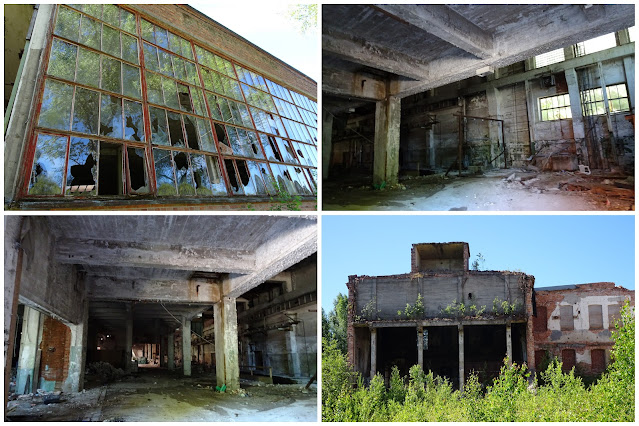Monday, 11 July - Deje, Värmland
After having spent the Sunday in Karlstad (and immediate surroundings), on Monday it was time for a longer day-trip, further up north in Värmland. Our first stop was at Deje, a village about 30 km north of Karlstad. My reasons were nostalgic: I wanted to see what (if anything) was left there of an old paper mill that was my first place of work after graduating from three terms of secretary school in Karlstad - 45 years ago. I held a temporary position there for 2-3 months in January-March 1977, as secretary/sales assistant. In retrospect, a very short time - but I learned a lot from it, and still have memories both of the premises and of people I worked with there.
 |
| Deje in 1977 - my photo |
The mill was built in 1906 to produce pulp and paper. In the mid 1960s it was one of the largest paper mills in the country. In 1977, it was struggling.
In an old post on my first blog, in 2009, I wrote down these memories from my time there:
"In the mid 70's, when I started working as a secretary, it was still pretty advanced to have an electric typewriter in the office. For copies you used carbon paper; or if you wanted more copies you could write on stencils, which were then put through a huge manual stencil copier, a messy process which usually left you with ink stained fingers.
One of the first offices I worked in was at a small paper mill. There we also had telex machine. When this started ticking, the whole staff used to gather around it, excited to see if it might be an order coming in. Sending was a more complicated process - you first had to use a special kind of typewriter to punch holes in a narrow strip of paper, then put the strip of paper through the machine (where it sometimes got stuck or ripped off and you had to start over...). But when sometimes after just a few minutes you got a written reply back from another country, it felt like a miracle."
In 1978, the pulp production was abandoned, but they continued making paper from pulp from some other mill. In 1985, the paper mill went bankrupt. Ownership changed, probably more than once. In 1997, the factory was taken over by a company recycling plastic waste. (I got these dates from a Swedish blog from a decade ago that Google found for me.)
Now, in 2022, it's all in ruins; and whoever owns it, they obviously can't afford neither to repair it, nor tear it down properly and decontaminate the grounds, nor even put up fences to keep people out. The photographer in me found it quite fascinating to be able to wander around there freely with my camera - but had I been a parent living in the village, I would have been seriously worried about teenagers hanging out there and getting up to all sorts...

.JPG)



.JPG)


.JPG)


it really is sad and also sad that to tear a building down is so expensive. we have them every where here, abandoned buildings. you captured the beauty and sadness with your lens. I remember those days of ink stain fingers and there were two paper mills in my home town, both went out of business just about the time yours did
ReplyDeleteThanks Sandra - good to know I managed to convey my feelings :)
DeleteI seem to remember that my husband visited the mill at Deje, when he first joined Uddeholm. Part of the introduction course, I think, as he visited quite a few mills and factories in the area. I can also remember being taken round a couple of mills too. As the wife of an employee, it was considered a useful in sight into my husband's job.
ReplyDeleteIt's such a shame that the buildings can't be re-purposed.
CG, that sounds likely. It was still Uddeholm who owned the mill at Deje when I worked there in 1977. In spite of me only standing in for another secretary for a couple of months, I remember being given a thorough introduction there too - not just the office, but I also got to see the machine hall, and learned a bit about the various qualities of paper they produced etc.
DeleteA Lost Place, and open to everyone - can‘t imagine that where I live! Of course, I would have had a good wander around, as you did.
ReplyDeleteWe never really forget our first work experience, do we. The world was a very different place back then.
It certainly was, Meike, and this trip for me was full of memories and trying to grasp how much time has really passed since back when I lived up there.
DeleteThere is a fascination in the ugliness and danger of decay. I would imagine it must be an extremely odd feeling to see it in it's present state having known it so long ago.
ReplyDeleteGraham, it was incredibly sad and utterly fascinating all in one. (And hard to quite grasp it was the same place at all.)
Delete